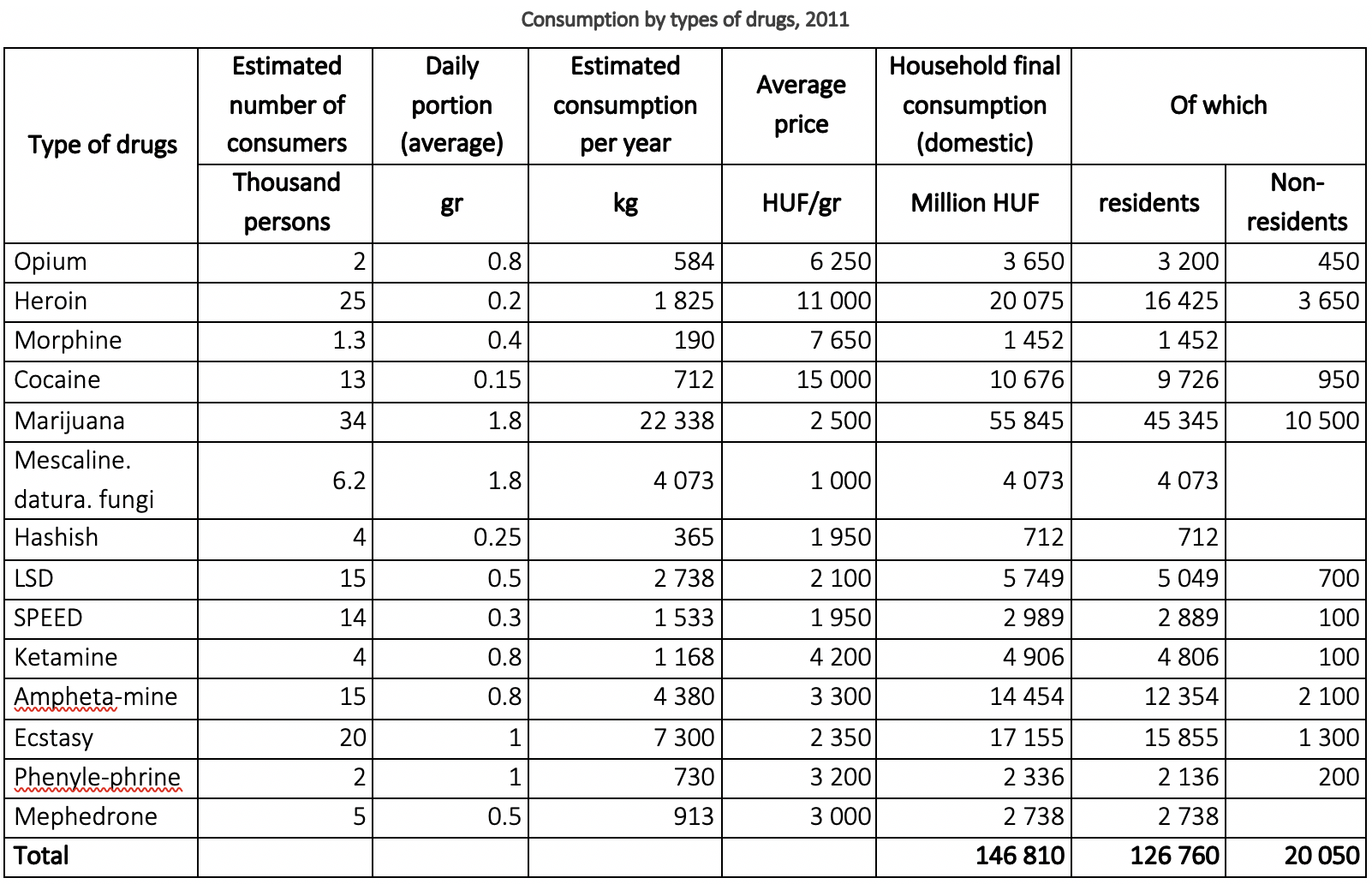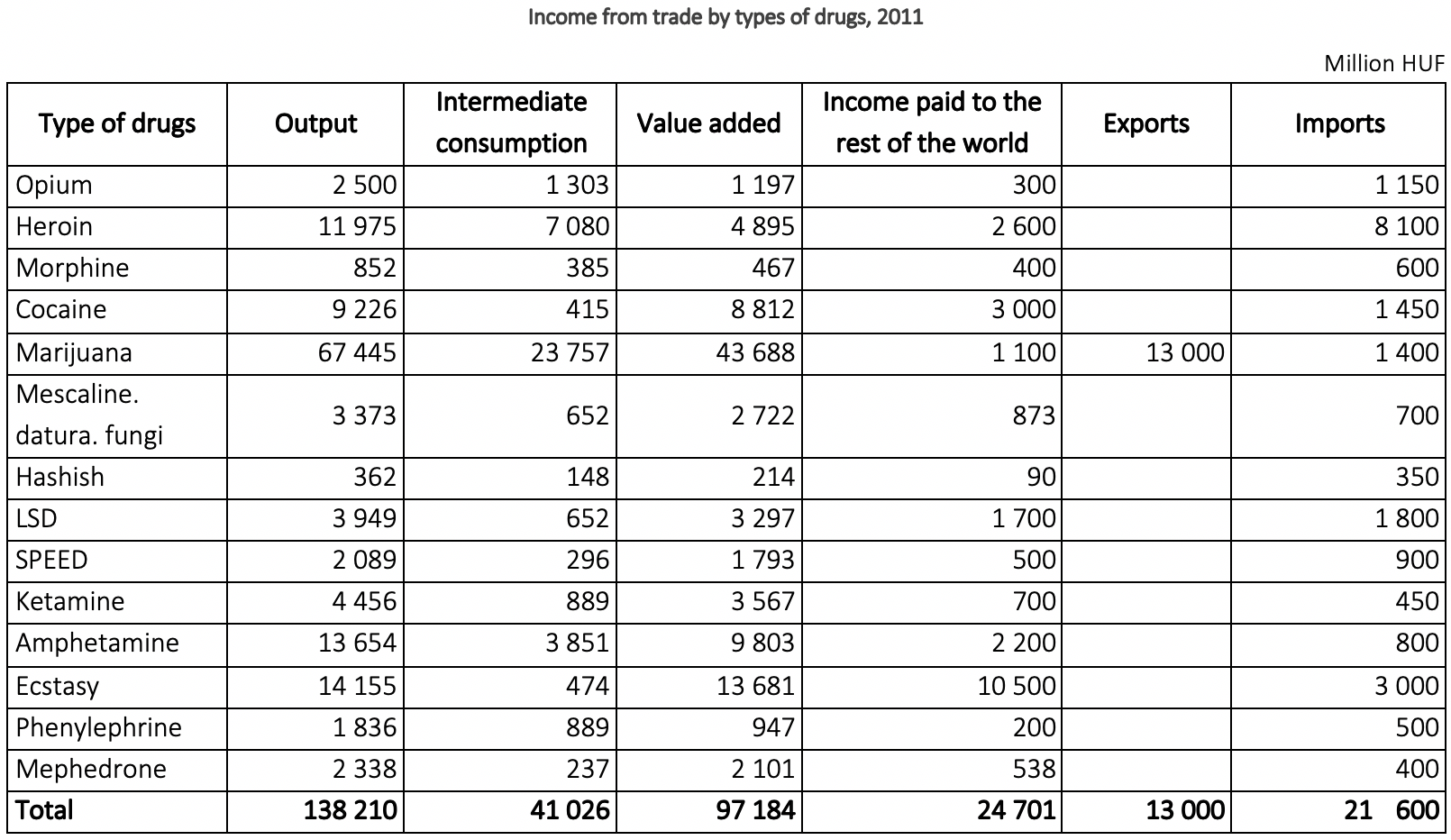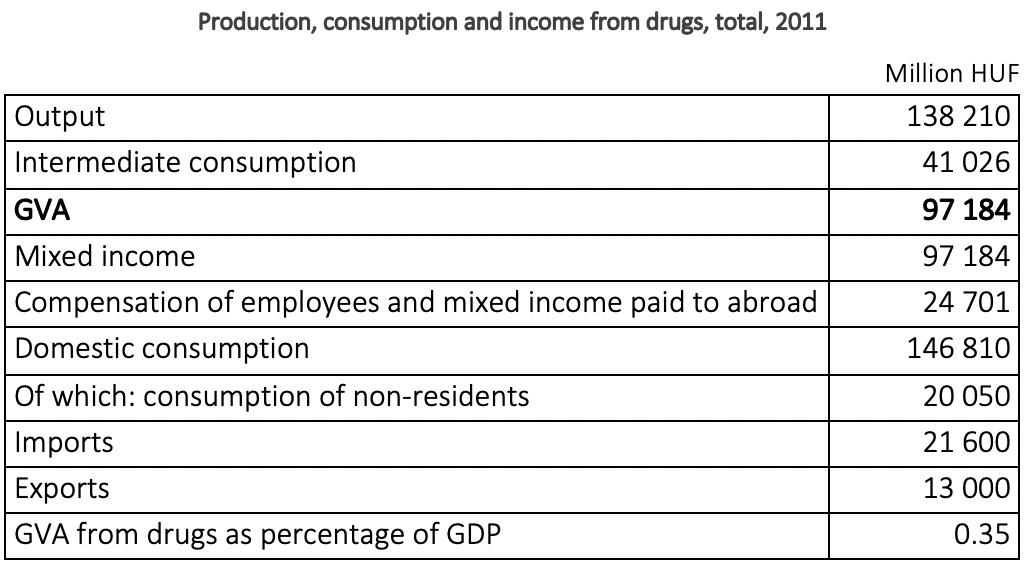 HUNGARY: Estimation of Drug Distribution and Production in the Hungarian National Accounts
HUNGARY: Estimation of Drug Distribution and Production in the Hungarian National Accounts
Introduction
In Hungary the figures of illegal activities are calculated in the framework of National Accounts for the following three types of activities:
- drugs
- prostitution
- smuggling of tobacco
Including these transactions in the National Accounts have impact on the output, intermediate consumption, gross value added, final consumption and export and import figures. The results of the calculations for exports and imports are transmitted to the external trade statistics and balance of payments statistics.
The following summary of the methodology of the estimation of drug distribution and production is based on the ESA 2010 GNI Inventory of Hungary (2015) the reference year of the calculation is 2011 as reported in the GNI Questionnaire 2015. According to the Hungarian legislations the production, distribution and possessing drugs over a certain quantity are illegal, so the production, consumption and income deriving from this activity are a part of the hidden economy.
For the estimation of income and consumption deriving from drug distribution and production, we estimate yearly:
- the number of persons using drugs by types of drugs,
- the quantity of purchased drugs,
- the average market price of drugs put into circulation,
- the income coming from trade of drugs by residency of traders
- the value of domestic production.
Output, Consumption and Income From Drugs
There are several institutions that provide estimates on the number of drug consumers annually, and - apart from that some civil organizations - publish their calculations. The report of the Drug Committee has great importance, this Committee has to report on the spread of drugs to the Parliament annually. Every second year the Government’s report on the situation of youth describes the success and failures of the struggle against the use of drugs. The departments of the police specialized on this matter report their experiences and opinions on the spread of drugs. There is a Country Report to European Monitoring Centre for the Drugs and Drug Addiction every year. On the basis of the above mentioned official findings, it can be said, that in Hungary there are about 200 thousand persons (about 2 per cent of the total population) more or less addicted to drug consumption, including also the occasional consumers.
Ten per cent of the consumers of drugs prepare the narcotic for own use from glue, paint-thinner and pills. They are part of the above mentioned 200 thousand persons, but they do not belong to the drug market. Mostly for financial reasons, they are not ordinary drug consumers, because they are not able to purchase narcotics from their income. In the calculation of gross value added from illegal activities their purchases are not included, because their consumed items (glues, paint thinner and pills) are already counted elsewhere.
After eliminating the above mentioned not ordinary consumers, the remaining 180 thousand comprises about 50 thousand drug addict, 80 thousand regular consumers and about 50 thousand occasional consumers. The consumption of occasional consumers are not taken into account in the estimates, because their consumption is highly volatile and incidental. About one third of the addict and regular consumers take pills (LSD, SPEED, Ecstasy, Amphetamine), nineteen percent take Marijuana and fourteen percent take Heroin. The number of hashish- and mescaline consumers is relatively low. These were the starting values from the first years of the calculation, for the following years (and in the backward calculation) the numbers of consumers were revised if it was necessary.
The quantity of purchased drugs is determined by the number of drug consumers and the daily consumed doses. To determine the usual daily doses we used, above all, the findings published in medical papers. The quantity of dose we got this way is just a basis for the further calculation, because even a drug addict doesn’t shoot up every day. So their annual consumption is less than the daily consumption multiplied by 365. Besides, we have to take into consideration the smaller purchases of the regular, but not addict consumers. Because of that the daily dose of an average consumer is always much less than the medical dose that was the starting point. For example, according to the Hungarian calculation the daily dose of an average heroin-consumer is 0.2 milligram, while an addict consumer’s is 0.5 milligram that he/she consumes on a certain day. Thereby, that even the addict consumers don’t consume it every day, plus the smaller consumption of regular, but not addict consumers lower the digits of the average consumption – the theoretical 0.5 milligram daily dose became 0.3 milligram daily dose in the practice. Using the similar calculating method, the theoretical 3-3.5 gram daily dose of marijuana will be 2 gram during the calculation of the consumption in practice.
Multiplying the practical daily doses by the estimated number of 130 thousand consumers we get about between 30 and 40 tons of consumed drugs annually. The authorities of custom officers, and police each seize about 1.5-2 tons of drugs yearly, so the ratio of reconnaissance is between 5-10 per cent out of the total consumption that is similar to the international practice as far as we know.
The sale prices of the distributed drugs are published regularly in the reports of the police and the custom officers, as well. These reports are available in the official reports of criminal investigation organizations and in the ordinary daily papers. The punishment of the detected drug dealers mostly depends on the quantity and estimated value of drugs having on them, so the data of the detection are generally published by the authorities. The data published by the authorities are always at domestic “retail” price and not at import price that is much less, namely one fourth or one fifth of that. Since the quantity and the value are published, it is possible to calculate the average price and its change in time. It can be stated that the membership of Hungary in the European Union a bit lowered the previous risks of drug trade that is proved by the stagnation or slight decrease of average drug prices, too.
At the beginning of the 90’s the developers of the domestic drug market were foreign criminals, because only they knew the production and manufacturing centres of drugs and the connected network of dealers. The leaders of drug trade were typically foreigners, only the dealers that spoke Hungarian and knew the local conditions better were Hungarians. About half part of the income deriving from drug trade belonged to foreign possessors, but by now this ratio decreased by a fifth. Short statements about foreign drug dealers are published in the annual report of the Supreme Prosecutor’s Office and in the Yearbook of the National Security Office every year. According to the latest report of the National Security, the spread of number of foreign drug dealers stopped in Hungary but lately, their income conditions became stable or even a bit stronger.
The negative impact of illegal income on the balance of foreign trade and the BOP - (i.e., a quarter of income deriving from drug are brought abroad) - is slightly reduced by the fact, that 6-8 per cent of drugs sold in Hungary are purchased by foreigners as it is mentioned in several police report. For example, on several international events (like the Formula I. Race or the [rock & pop] Festival of Sziget) a third of the detected drug consumers were foreigners.
Income paid to abroad from illegal activity
The estimation was based on the annual reports of the Supreme Prosecutor’s Office and the findings of police concerning foreign crime perpetrators. During the estimation we made the assumption, that the ratio of foreign perpetrators abusing with drugs is higher than that of domestic perpetrators, namely this is the most common crime they commit. So we set the ratio of income paid to abroad from drug trade between the two ratios.





